Forget fancy gym trends—the best way to build powerful legs has existed since the 1860s. It’s the barbell, a timeless tool for strength and muscle growth.
Barbell training is not just for the upper body, but also an effective way to build strong legs.
Barbell leg exercises allow you to progressively overload muscles and help you build strength in your quads, hamstrings, glutes, and calves.
Trust me, it’ll make your legs bigger. It helped me build the foundation I needed, and it’ll deliver results you can’t get from any machine.
They can increase muscle size, boost power and athletic performance, and improve balance and stability.
Here are my top 15 barbell exercises with workout routines to supercharge your leg training.
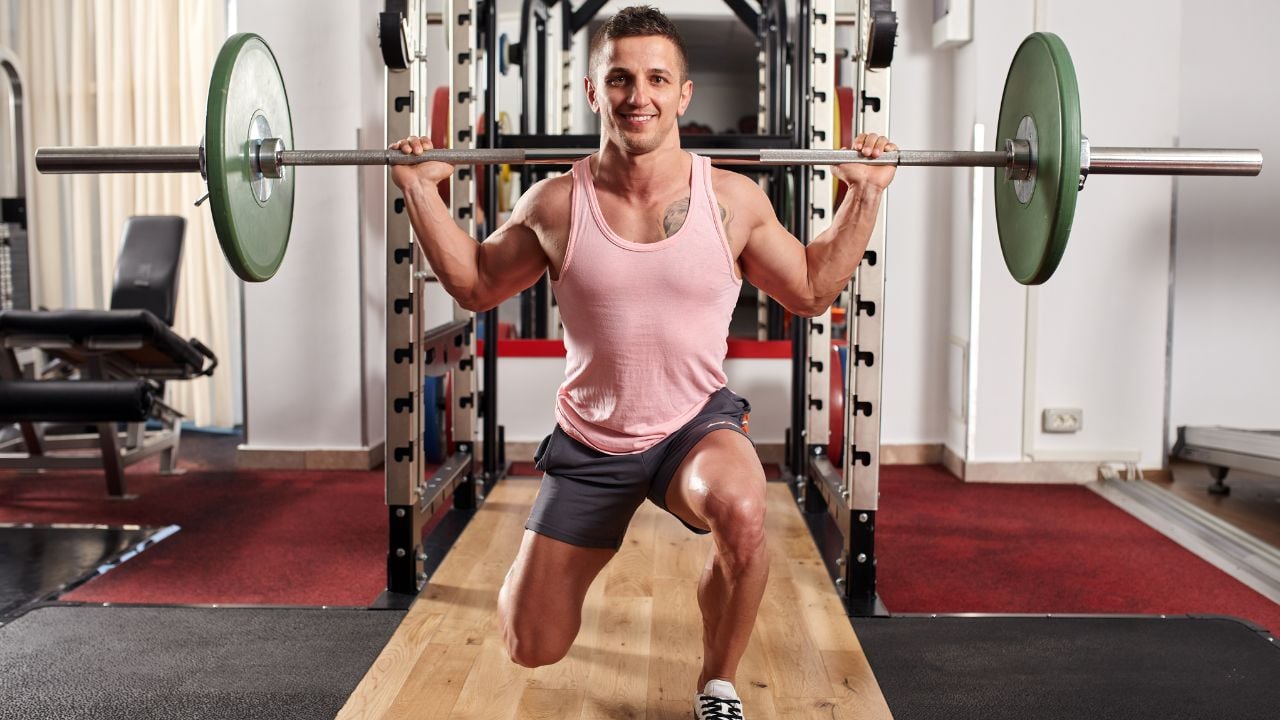
- 15 Best Barbell Leg Exercises
- 1. Barbell Squat
- 2. Front Squat
- 3. Deadlift
- 4. Stiff-Leg Barbell Deadlift
- 5. Barbell Lunges
- 6. Zercher Squat
- 7. Side Lunge
- 8. Jefferson Squat
- 9. Box Squat
- 10. Good Morning
- 10. Barbell Step Up
- 12 Barbell Hip Thrust
- 13. Barbell Hip Bridge
- 14. Barbell Standing Calf Raise
- 15. Barbell Seated Calf Raise
- Barbell Leg Training Techniques (With Workout Routine)
- 1. Select No. Of Sets
- 2. Choose No. Of Reps
- 3. Pick a training Plan As Per Your Goal
- 4. Add Varieties of your Leg Workout
- 5. Leg Barbell Workout Plan For Beginners
- FAQs
- How many reps and sets should I do for barbell leg exercises?
- How many exercises per leg workout
- How do you train your legs with a barbell?
- Can I train my legs every day?
- Does leg day increase testosterone?
- Takeaways
15 Best Barbell Leg Exercises
This blog describes all the major barbell leg exercises that train the quadriceps, hamstring, glutes, and Calf muscles.
1. Barbell Squat
The barbell squat is the king of all leg exercises. Nothing comes close to squat exercises for building muscle mass and toning the leg muscles.
Bodybuilders love squat exercises because they strengthen the legs and core. They shock the body into releasing testosterone and promote the development of body-wide muscle and strength.

How To Do
- Step on the rack so that the barbell rests across the back of your shoulders.
- Raise the barbell and get away from the rack if you are doing it with free weights.
- Bend your knees, lower your back straight, and head up until your thighs parallel the ground.
- Now, raise yourself up using only thigh power, keeping your back straight and legs nearly locked out.
Tips
- Keep your back straight, torso upright, head up, and feet flat.
- Start light and add weight gradually, allowing your legs and lower back to adapt.
- Concentrate on the form.
- If you are doing heavy squats, it is advisable to have a spotter or use a squat rack or power rack.
2. Front Squat
The barbell front squat is more advanced than the barbell squat and works the same target and synergistic muscles as a standard squat; however, it recruits more stabilizer muscles, including various back muscles, shoulders, and chest.
It helps build the entire thigh and focuses especially on the outer thigh region.
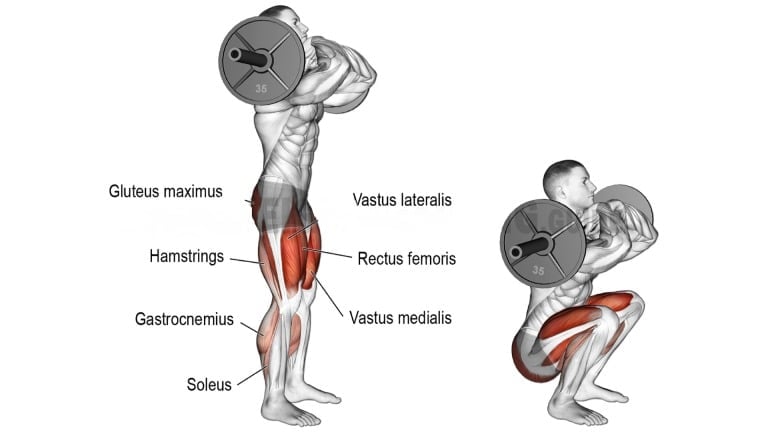
How To Do
- Step on a Smith machine and get the bar on your shoulders in front of you.
- Grasp it with your crossed arms and lift it off the rack.
- Maintain the natural arch in your lower back.
- To lower yourself, bend your knees and push your hips back until your thighs are parallel to the floor.
- Explosively drive through the floor to push yourself back to standing.
Tips
- Start light and add weight gradually, allowing your legs and lower back time to adapt.
- If lifting heavy, have a spotter ready, or use a squat rack or power rack.
3. Deadlift
The deadlift is the King of all exercises. It is the best exercise for posterior chain muscle strengthening.
It works your whole body, including the lower back, upper back, arms, legs, and buttocks. It recruits more muscle motor units than any other exercise.
When I started deadlifting, I was amazed at how quickly my hamstrings and glutes grew. You must try this.
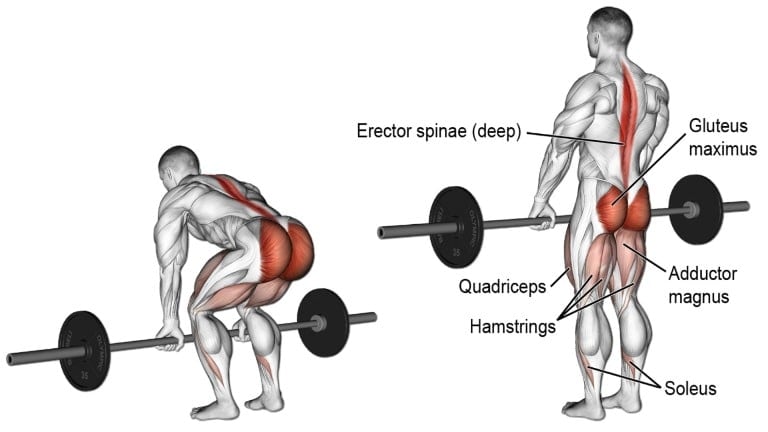
How To Do
- Grab the barbell with an overhand grip.
- Now raise the bar from the ground using your hamstrings and glutes.
- Raise it to the point where your body is erect.
- Do not hyperextend your body as the weight shifts to the lumbar spine.
- Hold the bar momentarily at the top of the lift and remember to lock out.
- Now lower the bar slowly and steadily by bending at the hips first and then at the knees.
- Let the weight touch the ground briefly before you begin the next rep.
Tips
- Remember that if a deadlift is performed incorrectly, it could cause more harm than good.
- Keep your back as straight as possible.
- Lower back muscles take a long time to recuperate; hence, heavy deadlifts will do the job once a week.
- Avoid jerky movements and keep them controlled.
4. Stiff-Leg Barbell Deadlift
If you’re looking for a straightforward leg workout that you can do with a barbell to build mass and strength, then a stiff leg deadlift is a great staple exercise to get you started.
It is a variation of the deadlift and an exercise used primarily to target the muscles of the hamstrings and gluteals.
It requires a lighter weight than that used during traditional powerlifting for strengthening the lower back, hamstring, and glute.
It is one of my favorite hamstring exercises, and I use it to train and build strong leg muscles.
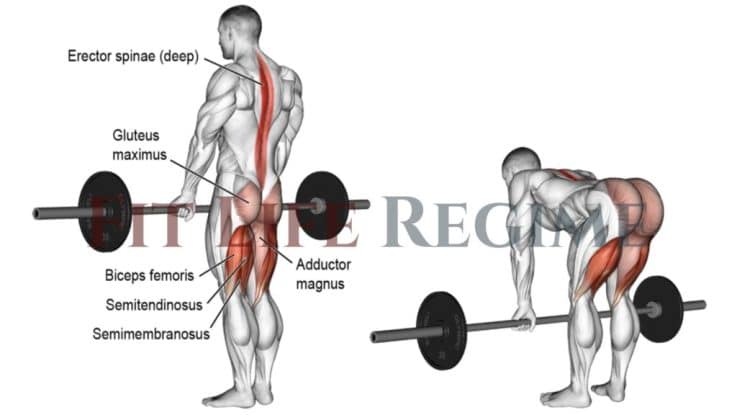
How To Do
- The barbell should be placed on the ground or on a low rack in front of you.
- You should allow your knees to bend slightly, but not too much, but not too much.
- Grasp a barbell using a shoulder-width pronated (overhand) or mixed grip.
- Keep your back straight, head up, and lift the barbell into a standing position.
- When you reach the top, push your hips forward to lock them out completely. Give your glutes a good squeeze at the top.
- Pause at the top before reversing the movement and slowly lowering the bar back down.
Tips
- Keep the bar close to you.
- Keep soft knees and ensure the movement occurs primarily at your hips.
5. Barbell Lunges
When doing a leg workout with a barbell, you must do a barbell lunge, as it is a brilliant exercise that helps strengthen your legs.
When we do a barbell lunge, our quadriceps muscles work the most. They also work on the hamstring and glute muscles.
Use barbell lunges leg exercises to develop balance, coordination, and the unilateral (one-sided) functional strength of your legs, which is important for athletic performance and overall fitness.
- Try another variation: barbell reverse lunges.
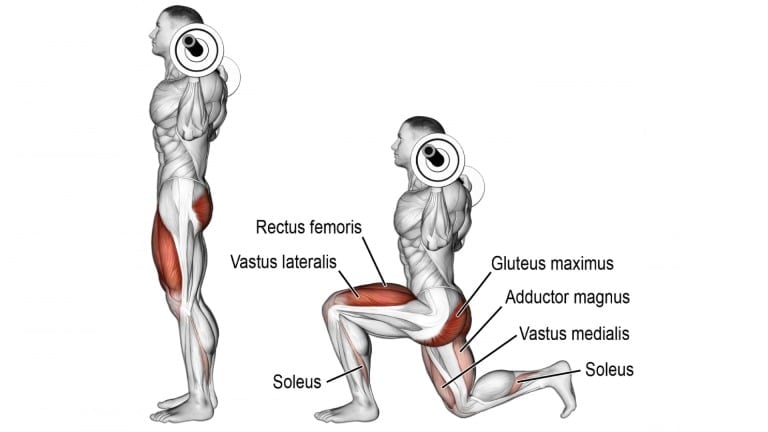
How To Do
- Set the barbell over a squat stand and position it at collarbone height.
- Hold a barbell across your upper back, just below the base of your neck.
- Step forward with one leg and lower your body until your back knee almost touches the ground.
- Ensure your front knee is bent at a 90-degree angle and your back knee hovers just above the ground.
- Hold the bottom position momentarily, then press yourself back to the starting position by engaging your front quadriceps.
- Complete all the repetitions for one leg before switching.
Tips
- You should always choose a load that allows you to train through a full range of motion.
- Bend as far and low as possible without losing form.
- If you suffer from balance issues, it is best to avoid them or do bodyweight lunges.
6. Zercher Squat
The Zercher squat is named after Ed Zercher, a strongman from the 1930s. Instead of holding the bar across the back or front muscles, hold it in the crooks of your elbows.
Reasons to do zercher squats:
- When you don’t have access to a squat rack.
- For strongman training and improving front-loaded carries
- To improve torso positioning and bracing for the squat
- As an accessory movement to build the deadlift
- To train for carrying people (firefighters, EMTs, etc.)
The main drawback you may feel is elbow discomfort from the arm position. So start light.
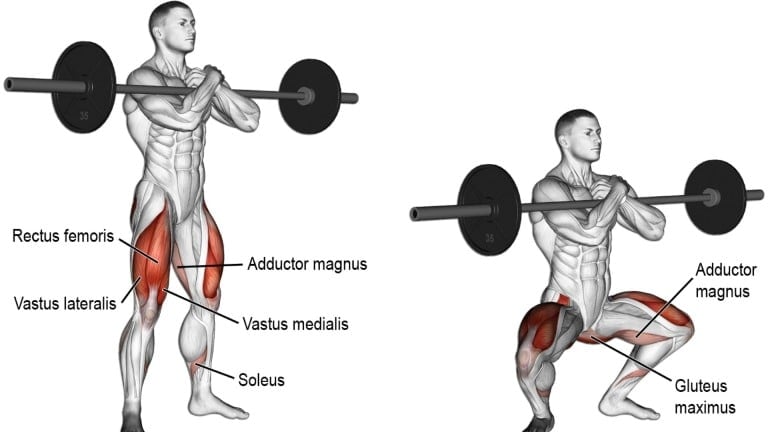
How To Do
- Hold a barbell at chest height with a shoulder-width grip in the crook of your crossed arms.
- Carefully step backward from the rack and stand with a wide stance.
- Your knees and feet should point out diagonally in the same direction.
- Keep your back straight and stand straight up.
- Move your glutes backward to lower yourself until the bar touches your legs.
- When your thighs are parallel to the ground, turn around and drive up with a lot of force through your heels to get yourself up.
Tips
- Clasp fingers together while holding the barbell.
- Do not round your back. Keep your back straight with a natural arch in your lower back.
- Use elbow pads to decrease arm discomfort.
7. Side Lunge
Like regular lunges, side lunges primarily target large muscle groups in the legs, such as the hamstrings and quads. Lateral lunges work the inner thigh muscles, such as the adductors and outer glutes.
The unilateral movement of side lunges can help you improve muscular imbalances and increase strength in each leg.
Lateral lunges heavily target the knee extensors (quadriceps) and ankle extensors (calves). This builds strength and power in the lower body.
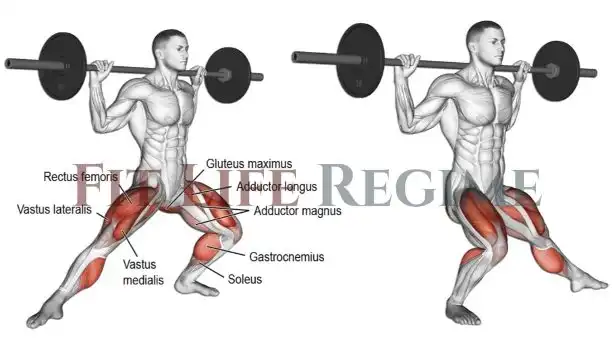
How To Do
- The barbell should be placed on the traps.
- Step out to your right as far as you can with your right foot.
- The forefoot should be turned out slightly as you plant it on the floor.
- Squat, shifting your weight to the left until your left leg is about parallel with the floor.
- Extend your left leg back up to lift your body up.
- Repeat with your left leg in the same manner, alternating legs each rep until all reps are completed.
Tips
- Do not lean the torso forward as you rise out of the bottom of the lunge.
- Always push through your heels to protect your knees.
8. Jefferson Squat
If you’re looking for a way to get more creative with your barbell leg workout, why not try Jefferson squats?
It is an old technique that few people use anymore, but it is an excellent workout because it tests and works your lower body.
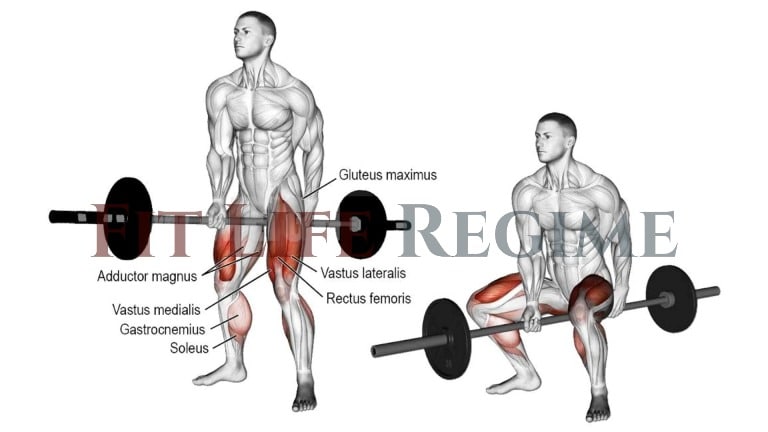
How To Do
- Straddle a loaded barbell placed on the floor and running sideways between your feet.
- Squat down to pick up the bar, grabbing it with one and facing palm backward and one hand facing palm forward.
- Hold the bar as you stand with a wider grip than shoulder-width.
- Bend at the knees and hips, letting your glutes track backward to lower yourself.
- When your thighs parallel the floor, reverse direction and drive up through your heels to a standing position.
Tips
- Keep your feet flat, your chest up, your back straight, and your shoulders back.
- Ensure that the weight is evenly distributed between your two legs.
- The lower you squat, the better the results will be. Use smaller weight plates to squat further.
9. Box Squat
A box squat is a compound exercise that works for muscle groups throughout your body.
It puts slightly less pressure on your knee joints than front or back squats.
This is a great exercise for learning how to squat because it reinforces the sitting-back portion of the squat. It is the best option for beginners.
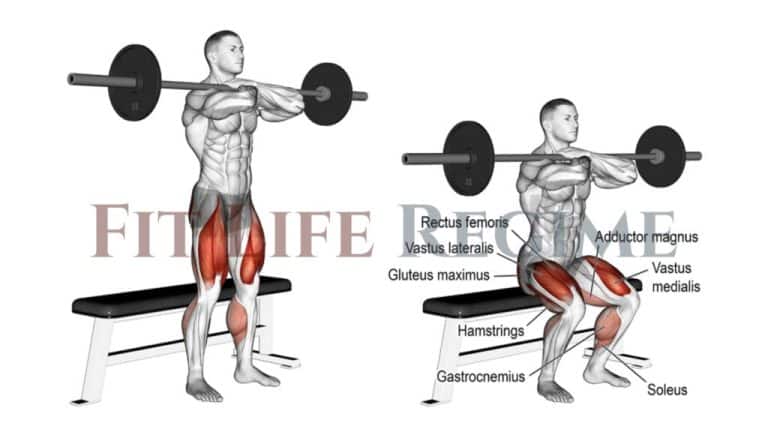
How To Do
- Place a box or bench that is about knee height behind you in the power rack or squat rack.
- Unrack the bar and move back so you are several inches ahead of the box or bench.
- Your posture should be tall, with your feet wider than hip-width apart and your knees slightly bent.
- Your shoulders should be directly over your hips, with your head and neck in a neutral position.
- Squat back and down until your glutes contact the box, and then return to the upright position.
Tips
- As you stand, keep your chest high and squeeze your glutes.
- Do not “plop” or fully sit down on the box.
- Do not sit on the box and rock backward, as this leads to spine compression; pause and immediately raise.
10. Good Morning
Good Morning is a compound exercise primarily targeting the lower back, glutes, and hamstrings.
While it is considered a pure hip extension exercise, good mornings also involve spine movement.
- The erector spinae muscles of the lower back work isometrically to keep the spine in an extended position,
- Meanwhile, the hamstrings and gluteus maximus work isotonically to extend the hips.
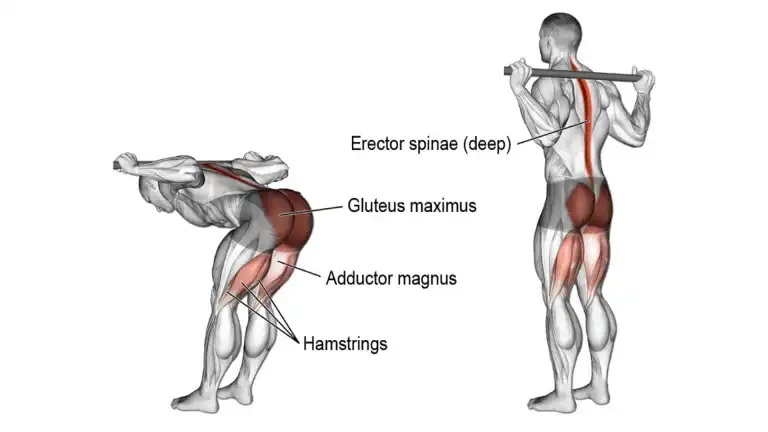
How To Do
- Stand with your feet shoulder-width apart, knees slightly bent.
- Place a barbell on your shoulders so the bar rests on the trapezius muscles of the upper back, near your shoulders.
- Begin the movement by unlocking your knees and hinging back into the hips while keeping your spine neutral.
- Inhale as you lower your torso until it is close to or completely horizontal.
- Exhale as you raise your torso back up to the starting position by stretching your hips.
Tips
- Keep your back and neck neutral throughout the exercise.
- It is recommended that the lifter avoid rounding (flexing) or rotation (twisting) at any point during the movement.
- Keep the movement slow, the form strict, and the weight light.
- Make sure to hinge at the hips and not the waist.
10. Barbell Step Up
The barbell step-up is a great exercise for building lower-body strength and power. It targets the quadriceps and involves calves, glutes, and hip flexors.
The step-up is a great all-around exercise that is perfect for everyone. It can be modified to create a challenging workout.
It has a low risk of injury and, with a few adjustments, offers a good cardio and strength workout.
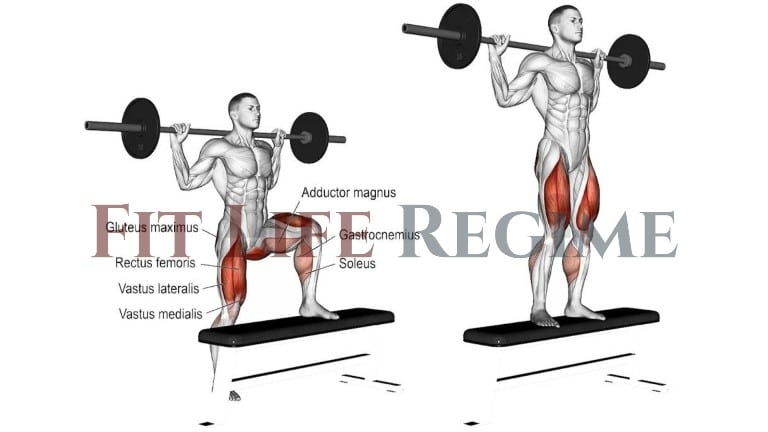
How To Do
- Place a knee-high box or bench in front of you and grasp a barbell supported on the back in each hand.
- Stand with your feet in a comfortable hip-width stance.
- Step forward with one leg onto the step and drive through that thigh to bring your body upward.
- Bring the trailing leg to the top of the step and stand on the box.
- Then, step back with the opposite leg to the floor and lower yourself.
- Alternate legs with each rep.
Tips
- Control the movement, using your muscles to lift and lower yourself slowly.
- Be sure to keep your lower back in its natural arch and your upper body upright throughout the whole movement.
- Keep your body upright and your feet and knees pointing in the same direction.
12 Barbell Hip Thrust
The barbell hip thrust is a popular exercise that targets the glutes and hamstrings to build muscle and strength.
Many people are afraid to perform this movement or are just not interested because it requires little setup and may even look funny.
I usually do 15–20 reps in a controlled manner to train my glutes effectively. You should also try this with light weights.
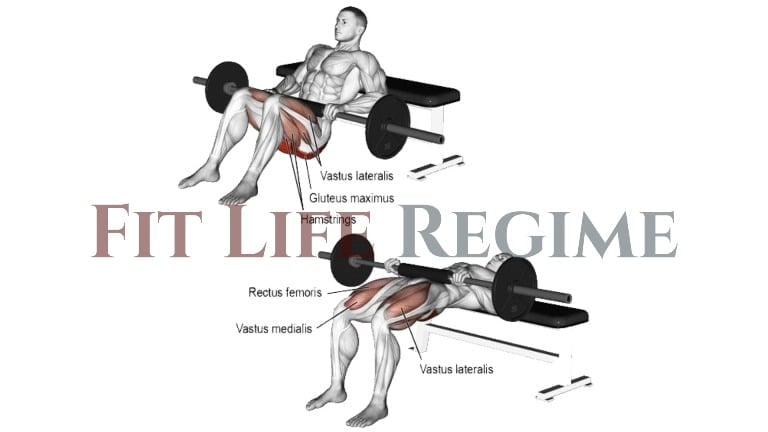
How To Do
- Place a loaded barbell next to and parallel to a bench.
- Slide your legs under the barbell and sit on the floor with your back against the side of a bench. The barbell should be over your hips.
- Grasp the barbell on each side. Bend your knees and place your feet flat on the floor.
- Keep your torso rigid, and exhale as you raise the barbell by extending your hips until they are fully extended.
- Hold for a count of two and squeeze your glutes.
- Inhale as you lower the barbell by flexing your hips. Do not allow the barbell to touch the floor.
Tips
- To prevent the bench from tipping over, place it against a wall.
- If the barbell hurts your pelvis, use padding.
- Keep your torso rigid. Your back shouldn’t arch, and your pelvis shouldn’t tilt.
- All the movement should occur in your hips.
13. Barbell Hip Bridge
When you spend most of your day sitting, your glute muscles can weaken, while the hip flexors in the front of your thighs can shorten, making them feel tight.
But when you practice glute bridges regularly, you target your glutes, hamstrings, and lower back muscles. Those muscles that are meant to hold your body upright will get stronger.
The study found that performing a bridge on an unstable surface can increase gluteus medius activity.
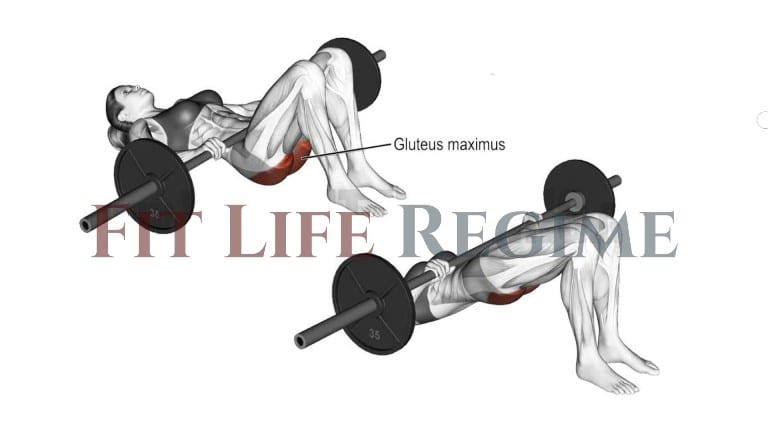
How To Do
- Lie supine (on your back) under a loaded barbell, with the bar over your hips.
- Grip the barbell to keep it in place, and flex both knees to plant both feet flat on the floor.
- Exhale as you raise the barbell off the floor by fully extending your hips.
- At the top of the movement, squeeze your glutes and hold for a count of two.
- Inhale as you slowly lower the barbell back to the floor.
Tips
- Do not push with your arms.
- Don’t overextend your back during the exercises, as this may cause lower back pain.
14. Barbell Standing Calf Raise
The barbell standing calf raise is a machine-based exercise targeting the muscles of the calves, particularly the gastrocnemius or upper calf muscle.
It is usually performed for moderate to high reps, such as 12–20 reps per set or more, as part of the lower body portion of a workout.
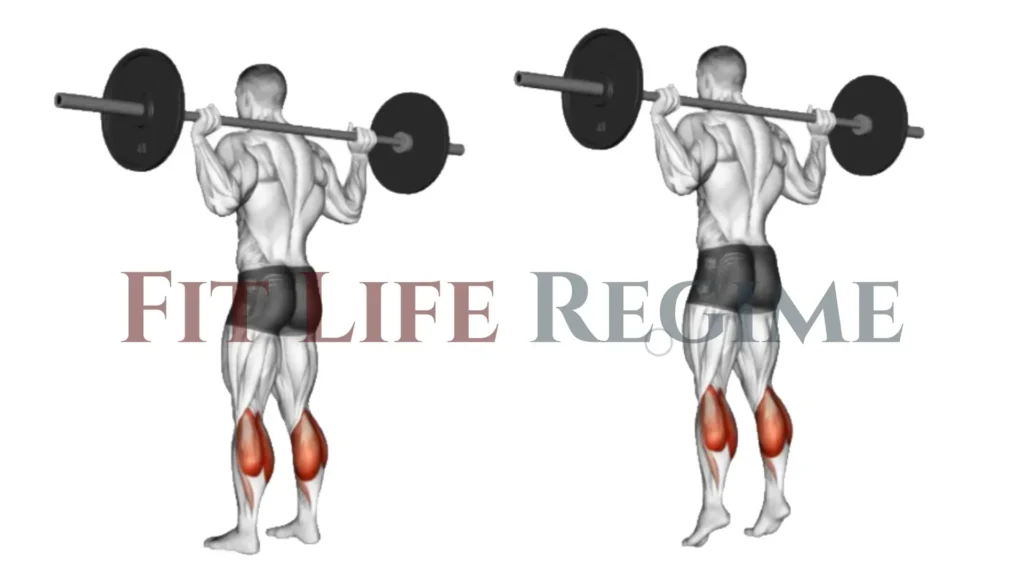
How To Do
- Stand upright with a barbell supported on your upper back.
- Hold the barbell with both hands facing forward.
- Push off the balls of your feet to raise your heels as high as possible.
- Flex your calf at the top of the contraction. Hold the contracted position for a second.
- Breathe in as you return to the starting position by lowering your heels.
Tips
- Your knees should remain extended.
- Don’t let your heels touch the floor throughout the set.
- To achieve the maximum range of motion, allow your heels to drop as far as possible and raise them as high as possible.
Related Post: 12 Best Calf Exercises And Workout For Building Bigger Calves
15. Barbell Seated Calf Raise
Finally, if you’re looking for one more effective leg workout, try the barbell seated calf raise.
The barbell seated calf raise is one of the best strength-gaining exercises. It targets your calf muscles and accelerates their growth.
It specifically activates and stresses the soleus calf muscle, so the exercise is best performed by maintaining a 90-degree angle at the knees.
I enjoy this exercise because I feel that my legs are completely trained after doing it.
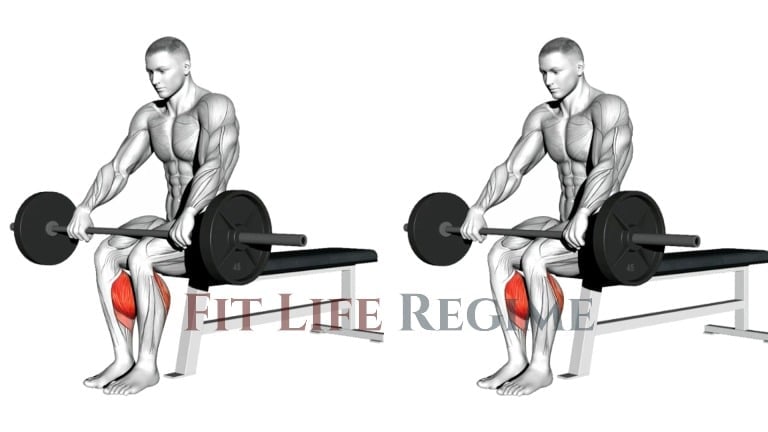
How To Do
- Sit on the end of a bench, chair, or anything similar, and place the barbell on the end of your thighs near your knee but not on your knee.
- Sit up straight and place the top half or balls of your feet on the elevated object so that your heels hang off.
- Lower your heels just until you feel a decent stretch in your calves.
- Then, flex your calf muscles to lift your heels as high as possible. Squeeze and hold for a second.
- Lower your heels back down and repeat.
Tips
- Do the reps in a controlled way and limit momentum at the movement’s top.
- To achieve the maximum range of motion, allow your heels to drop as far as possible and raise them as high as possible.
Know More: 7 Dumbbell Calf Exercises & Workouts For Bigger Calves
Barbell Leg Training Techniques (With Workout Routine)
Of course, the number of sets and reps will be determined based on your fitness journey, but here is a great starting point:
1. Select No. Of Sets
- Beginners: ~10 sets per week
- Intermediate: ~15 sets per week.
- Advanced: ~20 sets per week.
When a certain amount of volume stops being effective and your progress stalls, you can add sets to increase volume and use that as a driver of renewed progress.
2. Choose No. Of Reps
The best rep ranges and loads to work with.
- 6–8 reps with a heavy load
- 8–15 reps with moderate load
- 15-20+ with a light load
To be effective, the load should bring you to or near failure within the given rep ranges.
3. Pick a training Plan As Per Your Goal
- For muscle endurance: Aim for 3–4 sets of 12-15 reps, with moderate resistance.
- For muscle strength, aim for 3-5 sets of 6-10 reps with a heavier resistance.
- For muscle hypertrophy (increased muscle size), Aim for 3-4 sets of 8-12 reps, with moderate to heavy resistance.
It is always best to start with fewer reps and sets and then gradually increase as your strength improves.
4. Add Varieties of your Leg Workout
It’s a good idea to add various exercises to your leg workout routine to target the muscle from different angles and provide overall muscle growth.
Be smart: Don’t limit yourself to barbell leg exercises. Take advantage of their benefits and supplement them with other leg exercises when needed.
- Bodyweight Leg Exercises
- Best Dumbbell Leg Exercises To Build Bigger Legs
- Cable Leg Exercises & Workout
- Smith Machine Leg Workout & Exercises
A barbell workout can be easily incorporated into any training program. Adding dumbbells, body weights, machines, and cables to build the biggest, strongest legs is particularly effective.
5. Leg Barbell Workout Plan For Beginners
| Exercise | Sets | Reps | Rest Time |
|---|---|---|---|
| Barbell Squat | 3-4 | 8-10 | 60-90 sec |
| Barbell Deadlift | 3 | 6-8 | 60-90 sec |
| Walking Lunges | 3-4 | 8-10 | 60-90 sec |
| Calf Raises | 4 | 12-15 | 60-90 sec |
FAQs
How many reps and sets should I do for barbell leg exercises?
For most people, 3-4 sets of 8–12 reps are a good starting point. As you get stronger, you can increase weight and reps to keep challenging yourself and growing your muscles.
How many exercises per leg workout
The workout should consist of 3–5 exercises that target the major muscle groups in the legs.
It is important to prioritize exercises that work for multiple muscle groups, and to vary your exercises to avoid boredom and target different muscle groups.
How do you train your legs with a barbell?
To train your legs with a barbell, choose 3-5 exercises that target the major muscle groups in the legs, such as squats, deadlifts, lunges, step-ups, leg presses, and hamstrings.
Can I train my legs every day?
No, training your legs every day is not recommended. You need enough rest and recovery time to build and repair muscle.
Overtraining can lead to injury, muscle fatigue, and decreased performance.
Does leg day increase testosterone?
Yes, research has shown that doing leg exercises, especially heavy compound exercises like squats and deadlifts, can increase testosterone levels.
Testosterone is an important hormone for muscle growth and development, and leg exercises are particularly effective at increasing testosterone production.
Takeaways
If you’re a beginner or need to strengthen your legs, use the barbell without any weights. As you improve, or if you’re already advanced, add additional weight to increase the intensity.
These barbell leg exercises and Workouts are hard to beat! A strong lower body is important for overall health and fitness, so never skip a leg day!
References
- Wilk M, Petr M, Krzysztofik M, Zajac A, Stastny P. Endocrine response to high intensity barbell squats performed with constant movement tempo and variable training volume. Neuro Endocrinol Lett. 2018 Oct;39(4):342-348. PMID: 30531700.
- Riemann B, Congleton A, Ward R, Davies GJ. Biomechanical comparison of forward and lateral lunges at varying step lengths. J Sports Med Phys Fitness. 2013 Apr;53(2):130-8. PMID: 23584319.
- Kim S, Miller M, Tallarico A, Helder S, Liu Y, Lee S. Relationships between physical characteristics and biomechanics of lower extremity during the squat. J Exerc Sci Fit. 2021 Oct;19(4):269-277. doi: 10.1016/j.jesf.2021.09.002. Epub 2021 Oct 4. PMID: 34712337; PMCID: PMC8512761.
- Yoon JO, Kang MH, Kim JS, Oh JS. Effect of modified bridge exercise on trunk muscle activity in healthy adults: a cross sectional study. Braz J Phys Ther. 2018 Mar-Apr;22(2):161-167. doi: 10.1016/j.bjpt.2017.09.005. Epub 2017 Sep 9. PMID: 28943402; PMCID: PMC5883971.
- Lorenzetti S, Ostermann M, Zeidler F, et al. How to squat? Effects of various stance widths, foot placement angles and level of experience on knee, hip and trunk motion and loading. BMC Sports Sci Med Rehabil. 2018;10:14. doi:10.1186/s13102-018-0103-7

Manish brings over 10 years of hands-on experience in weight lifting and fat loss to fitness coaching. He specializes in gym-based training and has a lot of knowledge about exercise, lifting technique, biomechanics, and more.
Through “Fit Life Regime,” he generously shares the insights he’s gained over a decade in the field. His goal is to equip others with the knowledge to start their own fitness journey.
